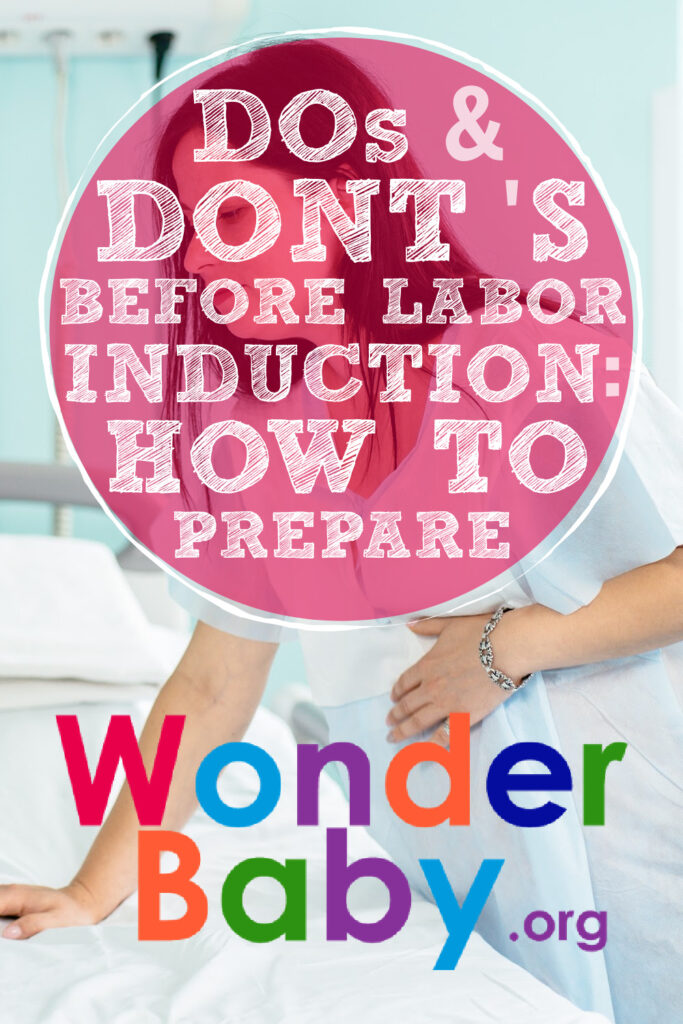Dos and Don’ts Before Labor Induction: How to Prepare

- Labor induction means using medicine to get your labor started.
- Labor may be induced if you are more than a week past your due date.
- Inducing labor is sometimes necessary to protect the health of the baby or mother.
- Induction is usually very safe and can promote better outcomes for high-risk mothers and their babies.
The goal of induction is to have a vaginal birth at a certain time. There are several reasons a pregnant woman may choose to have labor induced, including avoiding medical complications, being far past their due date, or wanting to schedule the birth of their baby.
Most women who have an induced labor are able to have a healthy vaginal delivery. However, labor induction does have some potential risks.
If you’re planning an induced labor, keep these important do’s and don’ts before labor induction in mind.
What is Labor Induction?

Induction of labor means getting labor started using some kind of medical intervention. There are several methods and medicines your healthcare provider can use to induce labor.
At Home Methods
While they are not truly considered medical interventions, many mothers try at-home methods like drinking midwives brew to get their labor started. Many women who are near the end of their pregnancy and ready to meet their new baby use at-home methods to help them go into spontaneous labor.
These include:
- Midwives brew
- Curb walking
- Nipple stimulation
- Intercourse
- Acupuncture
- Eating pineapple
- Drinking castor oil
Pregnant women should not use any of these methods before at least 39 weeks of pregnancy and should talk to their doctor to make sure they are ready.
Membrane Sweep
A membrane sweep is also known as stripping the membranes. If you choose to try this method of induction, your doctor will insert a gloved finger into your vagina to separate your amniotic sac from your uterine wall.
This separation signals to your body that it is time to start labor and can cause uterine contractions.
Amniotomy
Amniotomy is when a healthcare provider breaks your water using a small plastic instrument. Most women start labor a few hours after their water breaks.
Foley Bulb
Your doctor may insert a Foley catheter into your vagina and inflate the balloon to help your cervix dilate. The balloon will usually stay in place for at least thirty minutes, but healthcare providers may leave the balloon catheter there for up to 12 hours if your labor is not progressing.
Medications
There are two medications usually given during the induction of labor. Pitocin is a synthetic version of the hormone oxytocin and causes strong uterine contractions. Prostaglandins are also given to thin the lining of the cervix to prepare your body to deliver your baby.
12 Reasons to Induce Labor

Your healthcare provider may recommend induction to keep you and your baby safe. You may choose to have an elective induction if you and your healthcare providers determine that you are a good candidate.
Reasons for a labor induction include:
- Pregnancy longer than 41 weeks
- Pre-eclampsia
- Oligohydramnios11. Oligohydramnios. March of Dimes. 2023. https://www.marchofdimes.org/find-support/topics/planning-baby/oligohydramnios, or low amniotic fluid levels
- Baby has stopped growing
- Infection in the placenta
- Placental abruption
- Premature rupture of membranes
- Diabetes
- Rh blood incompatibility22. Cleveland Clinic Medical Professional. Rhesus (rh) factor: Incompatibility, Complications & Pregnancy. Cleveland Clinic. 2022. https://my.clevelandclinic.org/health/diseases/21053-rh-factor between you and your baby
- Scheduling labor for family members to be present
- History of very short labor
- Long commute to the hospital
What Are the Risks of Inducing Labor?
Many peer-reviewed studies have shown that inducing labor is safe for term pregnancies, and does not actually increase the risk of cesarean delivery. According to the Journal of Obstetrics and Gynecology33. Prysak, M., & Castronova, F. C.. Elective induction versus spontaneous labor: A case-control analysis of safety and efficacy. Obstetrics & Gynecology. 1998;92(1), 47–52. https://doi.org/10.1016/s0029-7844(98)00115-x, “Elective induction is commonly practiced, safe, and efficacious.”
Women who have pregnancy complications are more likely to need induction, which means that there are naturally more complications associated with the induction of labor. However, these complications can be attributed to pregnancy complications, not necessarily the labor induction itself.
While induction of labor is generally considered safe, there are a few risks to keep in mind.
Failed Induction
The most common problem with induction is that it doesn’t work. The American Journal of Obstetrics and Gynecology44. Ayala, N. K., & Rouse, D. J.. Failed induction of labor. American Journal of Obstetrics and Gynecology. 2022. https://doi.org/10.1016/j.ajog.2021.06.103 defines failed induction as not having a vaginal delivery after 12 to 18 hours of oxytocin administration.
If you have a failed induction, you may need to have a C-section delivery.
Increased Pain
Medications used to induce labor can cause harder uterine contractions during labor. Because of this, induced labor tends to be more painful than spontaneous labor.
If you had planned on natural childbirth, consider being flexible in your birth plan if you need an induction. Reconsidering the use of pain medication during labor does not mean you have failed.
Flexibility in your birth plan can help you have a good birth experience, even if everything doesn’t go exactly how you imagined.
Low Fetal Heart Rate
When oxytocin is used during labor, there is an increased risk that your baby’s heart rate will get too low. Your care team will carefully monitor your baby during labor and can stop the medication if they are concerned.
Infection
While rare, amniotomy and membrane sweep do increase the risk of infection in your uterus.
Postpartum bleeding
Your care providers will monitor you closely after giving birth to ensure that you are not bleeding too much. If you are soaking through several large pads each hour after delivery, your doctor may need to start pitocin to help your uterus contract and slow down the bleeding.
Uterine Rupture
Uterine rupture is an extremely rare complication of labor induction. Uterine rupture is more likely if you have had a recent C-section delivery. Mothers who want to have a vaginal birth after a cesarean section should discuss the risk of uterine rupture with their care provider.
Dos and Don’ts Before Labor Induction

If you are having an elective labor induction, think about these do’s and don’ts before being induced.
Do:
- Pack your hospital bag.
- Write down your questions.
- Communicate with your healthcare team.
- Be flexible in your birth plan.
- Manage your expectations.
- Eat a light meal before you go to the hospital.
- Get a good night’s sleep.
- Consider an epidural.
You should prepare for your induction just like you would if you were expecting to go into spontaneous labor. Pack your bag, bring a copy of your birth plan, ask questions, and try to get lots of rest.
Induced labor can cause stronger contractions than spontaneous labor, which can be painful. You may want to consider an epidural if you need labor induction.
Research published by the Journal of Obstetrics and Gynecology India55. Giugliano, E., Cagnazzo, E., Milillo, V., Moscarini, M., Vesce, F., Caserta, D., & Marci, R.. The risk factors for failure of labor induction: A cohort study. The Journal of Obstetrics and Gynecology of India. 2013;64(2), 111–115. https://doi.org/10.1007/s13224-013-0486-z shows that about 80% of inductions are successful. If your induction is in the 20% that do not work, it’s okay. Mothers who have a cesarean section can still have a positive experience with their baby’s birth.
Don’t:
- Try at-home induction methods right before your scheduled induction.
- Eat a large meal.
- Look up horror stories online.
Trying home remedies or eating a large meal before your induction can be dangerous. Home remedies may interact with the induction medication you are given in the hospital, and a large meal can cause problems if you have to have an emergency C-section.
Listening to friends’ scary stories or reading about labor complications online will only increase your anxiety. If you are worried, ask your healthcare provider to explain the risks of labor induction to you.
Labor Induction Contraindications
There are a few circumstances in which you should absolutely not have labor induction. These include:
- Placenta previa
- Myomectomy66. Vargas, V.. Myomectomy. JHM. 2022. https://www.hopkinsmedicine.org/health/treatment-tests-and-therapies/myomectomy-hysteroscopic-laparoscopic-abdominal#:~:text=Hysteroscopic%20myomectomy%20is%20the%20most,that%20can%20remove%20fibroid%20tissue. with entry into the uterine cavity
- Previous classical section delivery
- Active genital herpes outbreak
- Umbilical cord prolapse
- Transverse fetal lie
These conditions are not just contraindications for labor induction but for any vaginal delivery. If you have any of these conditions, you should speak to your healthcare provider about how to keep you and your baby safe.
While some of these things like the baby’s position or umbilical cord prolapse may be corrected as labor progresses, women with active genital herpes and placenta previa require a cesarean delivery.
How Long Does the Induction Process Last?

The length of the induction process is different for every mother. Some women will deliver their babies just a few hours after they are induced. Others may have to wait 24 hours or more to meet their new baby.
If you have had a Foley balloon, your membranes have been stripped, your water is broken, and you’ve been on Pitocin for 12–18 hours without making progress in your labor, you may need to have a C-section delivery.
FAQs
When is the best time for labor induction?
The best time for labor induction is when you have reached at least 39 weeks of pregnancy. If you plan to have a scheduled induction, try to wait until your baby has reached full term, unless there are medical reasons to deliver early.
Do I have to have an epidural if I am being induced?
Many women are able to have natural labor with induction, meaning they deliver their babies without using an epidural.
If you plan on having natural childbirth after induction, make sure you talk through pain management strategies with your healthcare team or a birthing coach.
Which is more painful: induced or spontaneous labor?
Expectant mothers, especially first-time moms are often afraid of the pain associated with delivering a baby. Both induced and spontaneous labor can be painful, but induction generally causes more intense pain as labor progresses.
Speak to your doctor about pain relief options that you feel comfortable with.
Is induction safe for VBAC deliveries?
Since every pregnancy is so different, you should talk to your healthcare provider if you plan to have an elective labor induction after a cesarean delivery. Your doctor will review your medical history with you to help you decide whether a VBAC is right for you.
References
- Oligohydramnios. March of Dimes. (2023, February). https://www.marchofdimes.org/find-support/topics/planning-baby/oligohydramnios
- Medical Professional, C. C. (2022, November 10). Rhesus (rh) factor: Incompatibility, Complications & Pregnancy. Cleveland Clinic. https://my.clevelandclinic.org/health/diseases/21053-rh-factor
- Prysak, M., & Castronova, F. C. (1998). Elective induction versus spontaneous labor: A case-control analysis of safety and efficacy. Obstetrics & Gynecology, 92(1), 47–52. https://doi.org/10.1016/s0029-7844(98)00115-x
- Ayala, N. K., & Rouse, D. J. (2022). Failed induction of labor. American Journal of Obstetrics and Gynecology. https://doi.org/10.1016/j.ajog.2021.06.103
- Giugliano, E., Cagnazzo, E., Milillo, V., Moscarini, M., Vesce, F., Caserta, D., & Marci, R. (2013). The risk factors for failure of labor induction: A cohort study. The Journal of Obstetrics and Gynecology of India, 64(2), 111–115. https://doi.org/10.1007/s13224-013-0486-z
- Vargas, V. (2022, November 21). Myomectomy. JHM. https://www.hopkinsmedicine.org/health/treatment-tests-and-therapies/myomectomy-hysteroscopic-laparoscopic-abdominal#:~:text=Hysteroscopic%20myomectomy%20is%20the%20most,that%20can%20remove%20fibroid%20tissue.

The information WonderBaby provides is not intended to be, and does not constitute, medical or other health advice or diagnosis and should not be used as such. Always consult with a qualified medical professional about your specific circumstances.
Related Posts

Pregnancy
How To Deal With an Ingrown Hair on a C-Section Scar
Ingrown hairs on a C-section scar can be treated using a warm compress or mild exfoliation. Infected ingrown hairs may require antibiotic treatment.

Pregnancy
What’s a Dye Stealer Pregnancy Test?
A dye stealer pregnancy test usually means that your hCG levels are very high, which is typically considered a good sign for pregnancy.

Pregnancy
Can Yelling Cause a Miscarriage?
Yelling alone can not cause a miscarriage. However, maternal stress can cause high blood pressure, preterm labor, and other health problems.